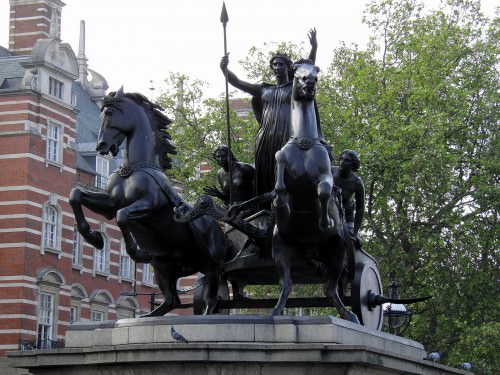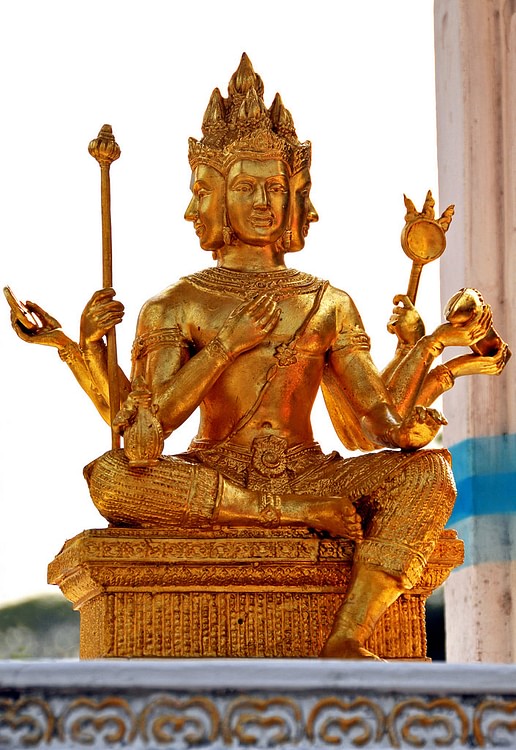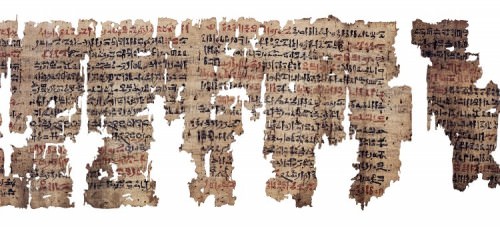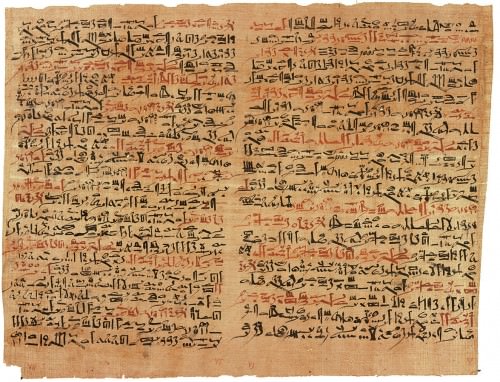Boudicca › Brahma › Ancient Egyptian Medical Texts » Origins and History
Articles and Definitions › Contents
- Boudicca › Who Was
- Brahma › Who Was
- Ancient Egyptian Medical Texts › Origins
Ancient civilizations › Historical places, and their characters
Boudicca › Who Was
Definition and Origins

Boudicca was the Celtic Queen of the Iceni tribe of modern-day East Anglia, Britain, who led a revolt against Rome in 60/61 CE. The Iceni King, Prasutagus, an independent ally of Rome, divided his estate between his daughters and King Nero of Rome. When Prasutagus died, however, his lands were taken by Rome and the Iceni lost their status as allies. When his wife, Boudicca, objected to this action she was flogged and her two daughters raped. She mounted a revolt against Rome which left the ancient Roman cities of Camulodunum, Londinium and Verulamium in ruins and over 80,000 Roman citizens of Britain dead. She was defeated at the Battle of Watling Street by the Roman Governor Gaius Suetonius Paulinus chiefly by his judicious choice of battlefield and allowing her army to cut off its own escape route by encircling their rear with their wagons, animals and families. Boudicca is said to have committed suicide by poisoning herself after her defeat.
The primary sources of the story of Boudicca's revolt are the Roman historians, Publius Cornelius Tacitus (56-117 CE) and Cassius Dio (150-235 CE). These two offer different versions of the story in that Tacitus claims the revolt sprang from the ill treatment of the Iceni following Prasutagus' death while Dio writes that the cause of the uprising was a dispute over a loan.
The other significant difference in the versions is that Dio makes no mention of the flogging of Boudicca or the rape of her daughters and claims she died of wounds incurred in battle, not by poisoning. Tacitus' account is generally accepted as being more factual because his father-in-law, Gnaeus Julius Agricola (40-93 CE) was the governor in Britain chiefly responsible for the successful conquest of the region and served as Tacitus' primary source of information. There is no doubt of Agricola's participation in the suppression of Boudicca's revolt, serving under Suetonius as a young soldier in 61 CE.
CAUSES OF BOUDICCA'S REBELLION
BOUDICCA WAS FLOGGED AND HER DAUGHTERS RAPED.
Tacitus writes, "Prasutagus, king of the Iceni, after a life of long and renownded prosperity, had made the emperor co-heir with his own two daughters. Prasutagus hoped by this submissiveness to preserve his kingdom and household from attack. But it turned out otherwise. [After his death] kingdom and household alike were plundered like prizes of war, the one by Roman officers, the other by Roman slaves. As a beginning, his widow Boudicca was flogged and their daughters raped. The Icenian chiefs were deprived of their hereditary estates as if the Romans had been given the whole country. The king's own relatives were treated like slaves. And the humiliated Iceni feared still worse, now that they had been reduced to provincial status. So they rebelled." (Eyewitness to Ancient Rome, 197).
The historian Miranda Aldhouse-Green cites an earlier Iceni rebellion, in 47 CE, as the cause of Prasutagus' elevation to chief of the tribe. This rebellion was unsuccessful and it is unclear what role Prasutagus played in it but it seems clear that the Romans saw Prasutagus as a leader who could keep the peace between the Iceni and Rome. Aldhouse-Green also notes the significance of Prasutagus' will, which divided his estate between his daughters and Rome and omitted Boudicca, as evidence of the queen's hostility toward Rome. It is argued that, by leaving her out of the will, Prasutagus hoped his daughters would continue his policy of cooperation. After his death, however, all hope of the Iceni existing peacefully with Rome was lost.
BOUDICCA'S WAR
Boudicca first struck the city of Camulodunum (modern Colchester) where she massacred the inhabitants and destroyed the settlement. Governor Suetonius was engaged in putting down an uprising on the Island of Mona and so the Roman citizens appealed to imperial agent Catus Decianus. He sent a lightly armed force of 200 men who proved ineffective in defense of the city. The Ninth Roman Division, led by Rufus, marched to relieve the settlement but were routed and the infantry decimated by the Briton forces. Tacticus cites the greed and rapacity of men like Catus Decianus for the viciousness of the Britons in revolt.

Boadicea Haranguing the Britons
Suetonius, returning from Mona, marched to Londinium (modern London) but, upon receiving intelligence that Boudicca's forces far outnumbered his own, left the city to its fate and sought a field more advantageous for battle. Boudicca's army sacked Londinium and, as before, massacred the inhabitants.
Suetonius had offered the people of the city safe passage with his army and it seems many accepted this offer. However, Tacitus writes, "but those who stayed because they were women, or old, or attached to the place, were slaughtered by the enemy. Verulamium suffered the same fate."
THE BATTLE OF WATLING STREET
While the Britons were destroying Verulamium (modern St. Albans) Suetonius "chose a position in a defile with a wood behind him. There could be no enemy, he knew, except at his front, where there was open country without cover for ambushes" (Tacitus). The Britons arrived to battle in "unprecedented numbers. Their confidence was such that they brought their wives with them to see the victory, installing them in carts stationed at the edge of the battlefield"(Tacitus). Both leaders are said to have encouraged and inspired their troops and then Suetonius gave the signal for battle and the infantry moved forward to throw their javelins. Boudicca's superior numbers were of no advantage in the narrow field Suetonius had chosen and, in fact, worked against her as the mass of men pushed together provided easy marks for the Romans.

Queen Boudica
The Britons fell back before the javelin assault and then the advancing wedge formation which cut through their ranks.Suetonius ordered in his auxiliary infantry and then his cavalry and the Britons turned to flee the field. The supply train they had arranged at their rear prevented their escape and the rout turned into a massacre. Tacitus writes, "the remaining Britons fled with difficulty since their ring of wagons blocked the outlets. The Romans did not spare even the women. Baggage animals too, transfixed with weapons, added to the heaps of dead." Boudicca and her daughters apparently managed to escape but, soon after, poisoned themselves to escape capture.
While the site of the battle is unknown, it is referred to as The Battle of Watling Street and suggestions as to precise location range from King's Cross, London to Church Stowe, Northamptonshire. Following Boudicca's defeat, Suetonius instituted harsher laws on the indigenous people of Britain until he was replaced by Publius Petronius Turpilianus who further secured the south of the region for Rome through gentler measures. Other, smaller, insurrections were mounted in the years following Boudicca's revolt but none gained the same wide spread support nor cost as many lives. The Romans would continue to hold Britain, without any further significant trouble, until their withdrawl from the region in 410 CE. Though she lost her battle and her cause, Boudicca is celebrated today as a national heroine and a universal symbol of the human desire for freedom and justice.
Brahma › Who Was
Definition and Origins

Brahma is the Hindu Creator god. He is also known as the Grandfather and as a later equivalent of Prajapati, the primeval first god. In early Hindu sources such as the Mahabharata, Brahma is supreme in the triad of great Hindu gods which includes Shiva and Vishnu.
Brahma, due to his elevated status, is less involved in picturesque myths where gods take on human form and character, but is rather a generally abstract or metaphysical ideal of a great god. In later Puranas (Hindu epics) Brahma is no longer worshipped and other gods are assigned his myths, even if he always maintains his status as the Creator god. Brahma's epithet is ekahamsa, the One Swan. His vahanam ('vehicle') is a peacock, swan or goose. He is still honoured today with an annual ceremony at the pilgrimage site of Pushkar in Rajasthan, India and he remains a popular figure in South-east Asia, especially in Thailand and Bali.
BRAHMA THE CREATOR
In the beginning, Brahma sprang from the cosmic golden egg and he then created good & evil and light & dark from his own person. He also created the four types: gods, demons, ancestors, and men (the first being Manu). Brahma then made all living creatures upon the earth (although in some myths Brahma's son Daksa is responsible for this). In the process of creating, perhaps in a moment of distraction, the demons were born from Brahma's thigh and so he abandoned his own body which then became Night. After Brahma created good gods he abandoned his body once again, which then became Day, hence demons gain the ascendancy at night and gods, the forces of goodness, rule the day. Brahma then created ancestors and men, each time again abandoning his body so that they became Dusk and Dawn respectively. This process of creation repeats itself in every aeon. Brahma then appointed Shiva to rule over humanity although in later myths Brahma becomes a servant of Shiva.
BRAHMA CREATED THE FOUR TYPES: GODS, DEMONS, ANCESTORS, AND MEN.
Brahma had several wives, the most important being his daughter Sarasvati who, after the Creation, bore Brahma the four Vedas (Holy books of Hinduism ), all branches of knowledge, the 36 Raginis and 6 Ragas of music, ideas such as Memory and Victory, yogas, religious acts, speech, Sanskrit, and the various units of measurement and time. Besides Daksa, Brahma had other notable sons including the Seven Sages (of whom Daksa was one), and the four famous Prajapatis (deities): Kardama, Pancasikha, Vodhu, and Narada, the latter being the messenger between gods and men.
BRAHMA CREATES WOMEN & DEATH
In the myths told in the Mahabharata, Brahma created women, the source of evil amongst men:
A wanton woman is a blazing fire...she is the sharp edge of the razor; she is poison, a serpent, and death all in one.
The gods feared that men could become so powerful that they might challenge their reign, therefore, they asked Brahma how best to prevent this. His response was to create wanton women who 'lusting for sensual pleasures, began to stir men up. Then the lord of gods, the lord, created anger as the assistant of desire, and all creatures, falling into the power of desire and anger, began to be attached to women.' ( Mahabharata in Hindu Myths, 36).
In another myth Brahma's first female is also Death, the evil force which brings balance to the universe and which ensures there is no over-crowding of it. The figure of Death is picturesquely described in the Mahabharata as 'a dark woman, wearing red garments, with red eyes and red palms and soles, adorned with divine ear-rings and ornaments' and she is given the job of 'destroying all creatures, imbeciles and scholars' without exception ( Mahabharata in Hindu Myths, 40). Death wept and begged Brahma to be released from this terrible task but Brahma remained unmoved and sent her on her way to perform her duty. At first Death continued her protests by performing various extraordinary acts of asceticism such as standing in water in complete silence for 8,000 years and standing on one toe on the top of the Himalaya mountains for 8,000 million years but Brahma would not be swayed. So Death, still sobbing, performed her duties bringing endless night to all things when their time came and her tears fell to the earth and became diseases. Thus, through Death's work, the distinction between mortals and gods was preserved forever.

Brahma
BRAHMA IN ART
Brahma is often represented in red with four heads, symbolic of his creation of the four Vedas. Thus he is often called Caturanana/Caturmukha or 'four-faced' and Astakarna or 'eight-eared'. Originally Brahma had five heads but when he lusted after his daughter Sandhya an outraged Shiva cut off the head which had ogled the goddess (or burned it with his central eye).Brahma is also represented with four arms. One right hand holds the brahma-tandram, an oval disk with a beaded rim which is perhaps a sacrificial ladle and used to mark men's foreheads with their destiny. The other right hand holds a rosary made from rudraksham seeds. One left hand holds a cleansing vase and he sometimes holds his bow Parivita or the Vedas.Brahma may also be depicted sitting on the sacred lotus flower which sprang from Vishnu's navel, a scene especially common in Cham art.
In Cambodian art, Brahma -known as Prah Prohm - is again represented with four heads and often riding a sacred goose, the hamsa (a popular form of depiction in Javanese art, too), and so the god may in this guise be referred to as Hansavahana. In Tibet, where Brahma is known as Tshangs-pa or White Brahma ( Tshangs-pa dkar-po ), he often rides a horse and carries a white bull and a sword.
Ancient Egyptian Medical Texts › Origins
Ancient Civilizations
Medicine in ancient Egypt was understood as a combination of practical technique and magical incantation and ritual.Although physical injury was usually addressed pragmatically through bandages, splints, and salves, even the broken bones and surgical procedures described in the medical texts were thought to have been made more effective through magic spells.

The London Medical Papyrus
These spells were recorded in the medical texts of the time, written on papyrus scrolls, and consulted by physicians when needed. In the present day, most people would balk at the idea of visiting a doctor and having incantations muttered over them while they were rubbed with oil and fumigated with incense as amulets and charms were swung over their bodies, but to the ancient Egyptians, this was all simply a routine aspect of the medical practice. As the Ebers Papyrus, one of the medical texts of its day, states, "Magic is effective together with medicine. Medicine is effective together with magic."
MAGIC & MEDICINE
The Egyptian god of magic was also their god of medicine, Heka, who carried a staff entwined with two serpents (no doubt taken from the Sumerian god Ninazu, son of the goddess of health and healing, Gula ). This symbol later traveled to Greecewhere it became the caduceus scepter of the healing god Asclepius and later associated with the "father of medicine," Hippocrates. The caduceus is recognized today as the symbol of the medical profession around the world. Magical practice and incantations invoked the power of the gods to accomplish one's goals, whether in medicine in in any other area of one's life. In medical practice, the spells, hymns, and incantations drew the gods near to the healer and focused their energies on the patient. Heka was the name of the god and also the practice of magic. According to Egyptologist Margaret Bunson:
Three basic elements were always involved in the practice of heka : the spell, the ritual, and the magician. Spells were traditional but also changed with the times and contained words which were viewed as powerful weapons in the hands of the learned. (154)
Doctors were well versed in magic and how it should be used most effectively. The doctor was the magician who knew the spells and the rituals which would unlock their power. When a doctor was called to a patient, he or she was expected to be able to cure the ailment because the gods would arrive once the proper spells were incanted along with the precise rituals. The triad of a doctor, spell, and ritual was considered as reliable by the ancient Egyptians as any medical procedure in the present day.
THE PAPYRUS SCROLLS
These spells were written down on scrolls made from the papyrus plant which was cut in strips, laid in layers, and pressed to create paper. These scrolls had two sides: the recto, where the fibers of the plant ran horizontally (the front) and the verso,where they ran vertically (the back). The recto was written on first as this was the preferred surface, but once this was filled, the verso was used for additional information or, sometimes, a completely different text. The Edwin Smith Papyrus, for example, has surgical procedures written on the recto with magical spells on the verso. Although some scholars have interpreted the two sides as a whole text, others have suggested that the spells were added to the papyrus later. Papyrus was fairly expensive and so was often recycled for other works either by writing over the recto side or using the verso or both.
THE TONE OF AUTHORITY IN ALL OF THE MEDICAL TEXTS IMPLIES EMPIRICAL KNOWLEDGE OF THE SUCCESS OF THE PRESCRIPTIONS & PROCEDURES.
The medical scrolls were preserved in a part of the temple known as the Per- Ankh ('House of Life'), which was an interesting combination of scriptorium, center of learning, library, and possibly hospital or medical school. Doctors were said to operate out of the Per-Ankh, but whether this meant they treated patients there, studied there, or simply referred to the knowledge they had obtained is unclear; it is possible the phrase meant all of the above. Temple complexes in ancient Egypt did serve as a kind of hospital and people are recorded as visiting them for assistance with medical problems. At the same time, of course, they were associated with centers of learning.
The spells which medical professionals would have learned were not considered arbitrary but had been proven effective through experience. The tone of authority in all of the medical texts implies empirical knowledge of the success of the prescriptions and procedures. The Erman Medical Papyrus, for example, authoritatively gives incantations and magical spells for the protection of children and healthy pregnancies. This text, dated to the Second Intermediate Period of Egypt (c. 1782-c. 1570 BCE) and most likely to c. 1600 BCE, is interesting for a number of reasons but, notably, for its reflection of medical knowledge in folk practice. The Magical Lullaby of ancient Egypt, sung or recited by mothers to protect their children from supernatural harm, shares many similarities with the incantations suggested in the Erman papyrus.
THE MEDICAL TEXTS
The different medical texts each address a different aspect of disease or injury. Each of them carries the name of the individual in the modern era who discovered, purchased, or donated the text to the museum which now houses it. The names by which the works were originally known have been lost.
Although there are many different papyri which mention magical spells, medical procedures, or both, only those directly associated with the practice of medicine - and thought to have been consulted by practicing doctors - are given below. A manuscript such as the Westcar Papyrus, for example, while it does shed light on practices surrounding birth, cannot be considered a medical text since it is obviously historical fiction.
The Berlin Medical Papyrus (Brugsch Papyrus) - Dated to the early New Kingdom of Egypt, this work is considered a copy of a much older medical treatise from the Middle Kingdom (2040-1782 BCE). The papyrus deals with contraception and fertility and includes instruction on the earliest known pregnancy tests in which a urine sample was taken from the woman and poured over vegetation; changes in hormone levels would be evident in the effect the urine had on the plants. Much of the advice in this work is also found in the Ebers Papyrus.
The Carlsberg Papyrus - A collection of different papyri from different eras spanning centuries. Parts of this papyrus date from the Middle Kingdom of Egypt, some from the New Kingdom, and others from as late as the 1st century CE. The New Kingdom segment is considered a copy of a text from the Middle Kingdom dealing with gynaecological issues, pregnancy, and eye problems. The different parts are written in hieratic, demotic, and ancient Greek.

Papyrus Chester Beatty VI
The Chester Beatty Medical Papyrus (also known as Papyrus Chester Beatty VI) - Dated to the New Kingdom (c. 1570 - c. 1069 BCE), and specifically to c. 1200 BCE, the text is written in demotic script and is the oldest treatise on anorectal disease (affecting the anus and rectum) in history. The work prescribes cannabis as an effective pain medication for what seems to be colorectal cancer as well as headaches; thus making the work an early instance of medicinal cannabis prescribed for cancer patients, predating Herodotus ' mention of the Scythian's use of cannabis as a recreational hallucinogen in his Histories (5th century BCE), which is generally considered the oldest mention of the drug.
The Demotic Magical Papyrus of London and Leiden - Dated to the 3rd century CE, this papyrus is written in demotic script and deals wholly with the supernatural aspects of disease, including spells for divination and raising someone from the dead.Advice is given to the doctor on how to induce visions and make contact with supernatural entities to cure a patient by driving out evil spirits.
The Ebers Papyrus - This copy, dated to the New Kingdom (specifically c. 1550 BCE), is also an older work from the Middle Kingdom. It discusses cancer (about which it says one can do nothing), heart disease, depression, diabetes, birth control, and many other concerns such as digestive problems and urinary tract infections. It offers both 'scientific' and supernatural diagnoses for disease and cure and includes a number of spells. It is the longest and most complete ancient Egyptian medical text found to date containing over 700 prescriptions and spells. Although the Egyptians had little knowledge of internal organs, they understood the heart was a pump which supplied blood to the rest of the body. Psychological problems are attributed to supernatural causes in the text in the same way physical disease is.
The Edwin Smith Papyrus - From the Second Intermediate Period (c. 1782-1570 BCE), this work is a copy of an earlier piece probably written in the Old Kingdom (c. 2613-2181 BCE). It is in hieratic script and dated to c. 1600 BCE. Some scholars attribute the original work to Imhotep (c. 2667-2600 BCE), best known as the architect of Djoser 's Step Pyramidconstructed toward the end of the Early Dynastic Period in Egypt (c. 3150 - c. 2613 BCE). Imhotep was also well respected for his medical treatises arguing that disease was natural, not a punishment from the gods or the result of evil spirits. Since the Edwin Smith Papyrus focuses on pragmatic treatments for injuries, Imhotep's claims would have at least influenced the work even if he did not write the original. It is the oldest known work on surgical techniques and was probably written for triage surgeons in field hospitals. The work focuses on practical application of easing pain and setting broken bones. As noted, the eight spells which appear on the verso side are considered by some scholars to be a later addition to the scroll.

Edwin Smith Papyrus
The Hearst Medical Papyrus - A New Kingdom copy in hieratic script of an older work thought to have been written in the period of the Middle Kingdom. The Hearst Medical Papyrus contains prescriptions for urinary tract infections, digestive problems, and other similar maladies. Although its authenticity has been questioned, it is generally accepted as legitimate. A number of the prescriptions repeat those found in the Ebers Papyrus and echoed in the Berlin Papyrus.
The Kahun Gynaecological Papyrus - Dated to the Middle Kingdom (specifically c. 1800 BCE), this papyrus deals with women's health and is thought to be the oldest such document on the subject. It covers contraception, conception, and pregnancy issues, as well as attendant problems linked to menstruation. It suggests that a woman with a severe headache, for example, is experiencing "discharges of the womb" and should be disinfected with incense, rubbed with oil, and the doctor should "have her eat a fresh ass liver" in order to recover. Many of the prescriptions deal with troubles emanating "from the womb" because, as Egyptologist Joyce Tyldesley notes, there was the "mistaken assumption that a healthy woman had a free passageway connecting her womb to the rest of her body" (33). Supernatural or natural disturbances in the womb, therefore, would affect the entire system of the individual, and so the womb becomes the focus in this work. Another medical text, The Ramasseum Medical Papyrus, is considered a New Kingdom copy of parts of this text.

Kahun Gynaecological Papyrus
The London Medical Papyrus - Dated to the Second Intermediate Period, this scroll consists of medicinal prescriptions and magical spells dealing with problems associated with the skin, eyes, pregnancy, and burns. The spells are to be used in conjunction with the medical applications, and the work is thought to have been a common reference book carried by practicing doctors. Some spells drive away evil spirits or ghosts while others were used to boost the healing properties of whatever treatment was applied.
CONCLUSION
All of these texts were as vital to the practice of medicine in ancient Egypt as any medical text in the present day. The prescriptions and procedures, which had proven effective in the past, were written down and preserved for other practitioners.Bunson writes:
Diagnostic procedures for injuries and diseases were common and extensive in Egyptian medical practice. The physicians consulted texts and made their own observations. Each physician listed the symptoms evident in a patient and then decided whether he had the skill to treat the condition. If a priest determined that a cure was possible, he reconsidered the remedies or therapeutic regimens available and proceeded accordingly. (158)
The skill of the Egyptian physician was widely recognized throughout the ancient world and their medical knowledge and procedures were emulated by the Greeks. Greek medicine was just as admired by Rome which adopted the same kinds of practices with the same sort of understanding of supernatural influences. The great Roman physician Galen (126 - c. 216 CE) was long understood to have learned his art from Cleopatra of Egypt, though a different Cleopatra from the famous queen.Roman medical practices lay the foundation for later understanding of the art of healing, and in this way, the ancient Egyptian texts continued to influence the medical profession up through the present day.
See other Related Content for Ancient History ››
LICENSE
Article based on information obtained from these sources:with permission from the Website Ancient History Encyclopedia
Content is available under License Creative Commons: Attribution-NonCommercial-ShareAlike 3.0 Unported. CC-BY-NC-SA License